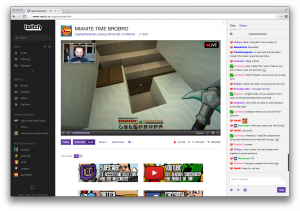
After more than 40 years of operation, DTVE is closing its doors and our website will no longer be updated daily. Thank you for all of your support.
Social climbing: social networks & OTT video
 Social networks have long been used to share video clips, but how viable are they as broadcast platforms in their own right? Andy McDonald reports.
Social networks have long been used to share video clips, but how viable are they as broadcast platforms in their own right? Andy McDonald reports.
Social networks have long been a place for people to share video clips, but recent developments hint at broader content aspirations among some of the main players in this space.
Earlier this year Snapchat partnered with a host of major TV broadcasters and publishers to launch a new in-app feature called Snapchat Discover, in a major step into the premium content space.
Twitter has long seen itself as a ‘second screen’ to TV, but as its relationship with the broadcast space continues to grow, it too has launched a new feature in the form of live video streaming platform Periscope.
Facebook is currently trialling a ‘suggested video’ feature in the US that promises to not only put a bigger emphasis on video but lead to partnerships and revenue sharing deals with premium content providers.
Elsewhere, the influence of the social web is clear to see. Not only are broadcasters like MTV looking to social video to inform their linear output, but new platforms like Twitch have also built huge video audiences online by tapping the power of the crowd.
Voyage of discovery
Snapchat unveiled its new Discover service in January with a host of big-name broadcast partners – including National Geographic, Vice Media, Comedy Central, Scripps and Sky. Announcing the update, Snapchat said that Discover will allow media companies to “build a storytelling format that puts the narrative first,” with the service supporting photos, videos, long-form text and advertising.
The launch marked a new direction for the messaging service, which was set up to let users send captioned photos and video clips to each other. Discover gives premium brands a place on the platform and lets them publish daily bulletins containing ‘snaps’, or stories.
Alan Strange, Sky News’ launch editor for Snapchat Discover says that the broadcaster is “always on the lookout on ways to attract new younger audiences” and has a “culture of experimentation” which fitted in well with the new service. “This was just a perfect marriage for us, because [Snapchat] are obviously bringing to the party a very large pre-existing user base, one that’s really active, and very hungry for mobile video, which is one of our strengths,” says Strange. He now oversees a dedicated team that works full-time to produce daily content for Snapchat Discover, with different staff members brought through each week to transfer skills internally.
“I really do see it as a way for us to experiment, to reach out to new audiences, improve our own story-telling,” says Strange. He says that Sky works across different platforms that have “their own little idiosyncrasies” and “different behaviours and habits.” Snapchat viewers in particular “want something more instant; they may not want the traditional 24-hour news cycle,” he says. “The kind of things that we would otherwise be known for at Sky News, which is the news as it happens, doesn’t necessarily translate over to Snapchat, because it’s not updatable every hour,” he adds, referring to Sky’s once-a-day publishing cycle for the platform.
Strange doesn’t reveal audience figures for Sky News on Snapchat Discover, but says Sky is “very happy” with the traction it is getting so far: “The numbers are really healthy and we’re working with Snapchat on ways to make them grow constantly.” He also said that Discover will be one of Snapchat’s “key priorities over the next few years” and that the messaging service wants Snapchat to be “the ultimate destination for millennials to get news”.
Twitter ups Periscope
Twitter has, for a number of years, positioned itself as a go-to companion service for TV. But with the launch of short-clip service Vine, and more recently live-video streaming platform Periscope, it is evolving its video strategy at the same time as it is forging an ever-closer relationship with the broadcast sector.
Dan Biddle, the head of broadcast partnerships at Twitter UK, says that Twitter and TV have a “symbiotic relationship” whereby TV drives Twitter activity, and Twitter activity in turn drives viewing. He says that Twitter takes the point where TV and Twitter coalesce and helps broadcasters make the most of that engagement, as well as monetise it through its Amplify ad service. Biddle refers to big TV moments that will prompt viewers to comment on the social network as the ‘Tweet-spot’ – events like someone being fired on The Apprentice, or eating something grotesque on I’m A Celebrity… Get Me Out of Here. Broadcasters will put clips on Twitter to accompany these moments, says Biddle, and with Amplify, Twitter lets them make money by adding short pre-roll advertising.
 Broadcasters and producers are increasingly thinking about these live moments in relation to Twitter, with people more likely to share content if it is presented to them in the first instance, says Biddle. “Whether it’s the producers themselves or whether it’s a channel marketing team, they will absolutely be saying ‘where’s the Twitter gold, what’s the Tweet-spot?’ You only have to look at BBC One and their Twitter feed or ITV and you’ll be able to see that these are broadcasters that are very much attuned to the power of real-time video and getting content out into Twitter to be shared as it is happening live on both screens,” he adds.
Broadcasters and producers are increasingly thinking about these live moments in relation to Twitter, with people more likely to share content if it is presented to them in the first instance, says Biddle. “Whether it’s the producers themselves or whether it’s a channel marketing team, they will absolutely be saying ‘where’s the Twitter gold, what’s the Tweet-spot?’ You only have to look at BBC One and their Twitter feed or ITV and you’ll be able to see that these are broadcasters that are very much attuned to the power of real-time video and getting content out into Twitter to be shared as it is happening live on both screens,” he adds.
With the launch of Periscope in March, Twitter is enabling broadcasters to experiment further. Biddle cites a number of UK examples where Periscope has been used by presenters and talent to give a behind-the-scenes glimpse at a broadcast – Ant and Dec during the semi-final of Britain’s Got Talent, Kay Burley during Sky News’ general election coverage, and Roger Federer during the opening stages of Wimbledon. As Biddle points out, in these cases, the audience is literally in the palm of the presenter’s hand, offering a powerful connection between them.
Facebook against YouTube
In January, Facebook reported that in the previous year the number of video posts per person on the service had increased 75% globally and 94% in the US. Worldwide, the amount of video from people and brands in the site’s news feed has increased by a factor of 3.6 year-on-year, and that on average more than half the people who use Facebook every day in the US watch at least one video daily.
With the service claiming to have averaged more than a billion video views every day since last September, video is clearly a core component. In an online ‘Townhall Q&A’ with Facebook users, CEO Mark Zuckerberg even said that in the future “video will be even more important than photos” on the service.
Facebook is now testing a ‘suggested video’ feature in the US, designed to serve up content based on what a user likes or is watching. Suggestions will appear as a video feed that starts playing as people scroll.
News of the plans broke at the beginning of July, with Facebook reportedly planning to share video ad revenues with content makers for the first time – offering a similar ad split to YouTube. Facebook is also rumoured to be to be trialling suggested video advertising with professional content providers like Fox Sports, Hearst, Funny or Die and the NBA.
Richard Broughton, research director at Ampere Analysis says: “I think there’s certainly a very strong incentive for content companies to start disseminating videos on Facebook – not least the fact that if there’s more competition in the market from a platform, it puts the content creators in a much better negotiating position. This means in a year’s time they can go back to YouTube, or indeed Facebook, and say ‘these guys are offering me better terms, what can you do to match it?’”
A recent Ampere research report claimed that Facebook is making a “serious play” for content owners and that recent trials with the likes of Fox Sports “suggest it’s primed to become a plausible alternative to YouTube.” Ampere predicted an “advertising ‘arms race’” between the social network and YouTube. “Ultimately, the objective with Facebook, as with most companies, is simply to make more money. Video is a good avenue for that, because video adverts are more expensive, so advertisers will pay more for them. So obviously Facebook’s been ramping up the video over the past few years to take advantage of those higher associated CPMs,” says Broughton.
IHS director for operators and mobile media Jack Kent agrees that Facebook’s move into the premium video space puts it more into competition with the likes of YouTube, and says the social network is now being “very aggressive in its video strategy”. Kent cites a recent partnership between Facebook and HBO as another example of its video ambitions, in which HBO offered free access to the first episode of its two latest comedy series, Ballers and The Brink, on Facebook for a limited time.
“Compared to YouTube the monetisation [on Facebook] might not necessarily be there yet. But if you look at the speed at which Facebook can change its business around – in 2012 mobile advertising revenues were virtually zero, now the vast majority of advertising comes from mobile. So Facebook can change its strategy quite quickly, to mobile and now to video,” says Kent.
MTV’s social rebrand
While it is now customary for broadcasters to use social media to connect with viewers, a recent MTV International rebrand is seeing the youth network harness the power of social networks for its linear output. In a bid to evolve the brand from ‘I want my MTV’ to ‘I am my MTV’, the network has begun to spotlight social media videos from its audience and talent, both on-air and across all platforms.
Viewers that share Instagram or Vine videos on Twitter with the tag #MTVbump could see their video appear on-air within two hours, in what MTV says is the first of many ways that it will open up the brand to young people. Viewers can also visit MTVbump.com to see all the ‘bumps’ that have made it on air around the world.
Tanya Leedekerken, MTV International’s vice-president of marketing, says the rebrand is designed to keep pace with the wider changes in the media landscape since MTV International unified its worldwide brands in 2008.
“We’ve upgraded that look throughout the years [but] it’s pretty close to where we started out. In the meantime the market has developed and we’ve noticed that the way that young people are consuming content over different screens and the way that they communicate with each other has really changed significantly. So for us, we felt that it really was time for MTV to take the next step in the constant evolution of the brand,” says Leedekerken.
She claims that new technology has surfaced “an enormous amount of talent amongst young people” that MTV wants to spotlight and celebrate.
“We really are looking to give back the brand to our audience and all the talent out there and give them the context to create and have fun on our channel in the [programming] breaks,” she says. “What we’ve essentially done is we’ve created a connection between broadcast technology and the internet and it’s fantastic because honestly this means that if somebody’s at V Festival in the UK and they’re producing this wonderful Instagram video it can be on-air in Sydney even a little bit quicker than the two hours. It can basically go on air almost immediately depending on how on-top of the curation people are.” Leedekerken says the initiative makes MTV feel “super topical, localised and immediate”, but that it also plays into the network’s wider strategy to seek ‘shares’, ‘likes’ and generate buzz for its programming on social media.
“Obviously MTV has a massive footprint – I think we have 304 million fans across all platforms, globally. We know that most of our audience is on social media, and we also know that one of the big topics on social media is television. So on our end, music and reality television are the perfect fuel for what we call ‘likeonomy’. Our content is produced with that in mind,” says Leedekerken.
Twitch’s social ascent
Twitch, a video platform and community for games enthusiasts, has grown into an online phenomenon over recent years. Initially borne out of broad-based live video platform, Justin.tv, Twitch launched as a standalone service just four years ago and has since grown its audience more than ten-fold to reach more than 100 million unique viewers per month.
Despite this, the first time that many non-gamers would have heard of the service was when Amazon acquired it for US$970 million (e880 million) in cash in August 2014 after reportedly fending off a rival approach from YouTube. “People ask me why is Twitch so successful? There are lots and lots of reasons why, but at its root I think it’s because gamers as a group tend to be very, very social people, despite what popular stereotypes might be of the shut-in basement-dwelling gamer guy. Nothing could actually be further from the truth,” says vice-president of marketing, Matthew DiPietro. “We launched Twitch in June of 2011 and it’s been a rocketship ever since. I think we have really profoundly affected the video game industry in particular. I think we’ve also provided an all-new, wholly different type of entertainment for gamers all over the world, and that’s something that I think we’re all very proud of.”
Gamers stream footage of themselves playing games, while others can watch, comment and interact on comment boards. The site now covers gaming events such as the E3 games expo in Los Angeles. DiPietro claims that the gameplay and the social aspect of the service go hand-in-hand and that the chat is “absolutely critical” to the Twitch experience. “Chat has essentially allowed the community to develop this language and this culture that is unique to Twitch, that doesn’t exist anywhere else,” says DiPietro. “The way that people speak to each other and express themselves through emoticons and through chat is really fascinating. If you’re not a Twitch user, it might seem a little bit bewildering, frankly. But it’s the thread that pulls everybody together… it’s the social fabric that connects the whole site.”
Although it has diversified somewhat in recent years, DiPietro says that the Twitch demographic skews to a younger, male audience that, crucially for advertisers, tend to be cord-cutters and do not have a cable TV subscription. “They consume content over-the-top, on mobile, on game devices and things like that. They just don’t watch television – broadcast, cable or otherwise. They watch things like Twitch.”
For this audience, traditional marketing channels are becoming “increasingly irrelevant”, says DiPietro. While games companies and platforms have predictably embraced Twitch “in a profound way” as a means to promote their titles and products, a more interesting development has been that “non-endemic brands are starting to tune into the value of Twitch as a platform,” he says. Large consumer brands like Taco Bell, Old Spice and Coca Cola are now turning to Twitch because its audience is a “very, very hard audience for advertisers to get their message in front of.”
While social media is not replacing broadcast television, the lines between social and broadcast content are becoming increasingly blurred. The TV industry uses social platforms for promotion, but the power that these services now wield and their own video aspirations could make them a force to be reckoned with in years to come.


